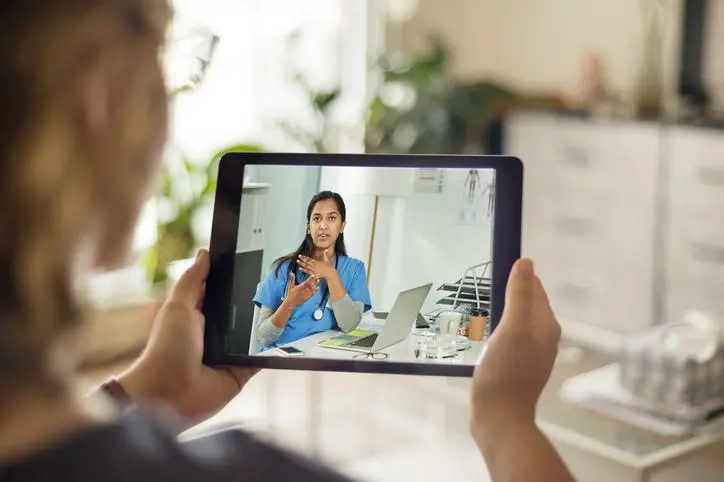PHOTO
As the COVID-19 pandemic raged, patients increasingly avoided in-person consultations and turned to remote solutions. The result is a surge in demand for telemedicine services in the Gulf region, especially since they have proven more efficient in delivering primary healthcare services than the traditional route.
According to a report published by Derasat, a Bahrain-based think tank, government agencies across the Gulf region have played a major role in driving healthcare facilities to offer telehealth services, which refer to the delivery of remote clinical services ranging from teleconsultations to online prescriptions.
In May 2020, the first telemedicine service in Bahrain licensed by the National Health Regulatory Authority went online through Doctori, a local telemedicine start-up. In December 2020, five companies in Bahrain were licensed to offer virtual health services.
In the UAE, the Dubai Health Authority’s (DHA’s) Doctor for Every Citizen, a telemedicine service, provided more than 83,000 remote consultations in 2020. According to Dr Manal Taryam, CEO of Primary Healthcare, DHA, the authority has now increased the number of doctors from 10 to 52 and the number of stations used for virtual consultations from 6 to 16.
DIGITAL HEALTHCARE GOES MAINSTREAM
“The COVID-19 pandemic has served as a catalyst for digitalisation for all sectors across the board,” Ahmed Mahmood, CEO of Doctori, told Zawya. “It is hardly surprising that this would be the case for healthcare too.”
One of the biggest advantages of teleconsultation is that it allows patients to directly communicate with doctors from the comfort of their homes. UAE-based Aster DM Healthcare, a private healthcare provider, rapidly moved to adopt telemedicine protocols early and now has more than 800 doctors across the UAE, Qatar, Oman, Saudi, and India actively using telemedicine facilities to consult patients.
“It has become a go-to choice for many [patients]. The entire shift in the process of seeking an appointment, teleconsultation with the doctor, follow-up call, lab test, and medicine delivery at home has made the experience convenient and time-savvy for our patients,” Alisha Moopen, Deputy Managing Director, Aster DM Healthcare, told Zawya.
Meanwhile, vHealth, another UAE-based telehealth provider, said that the company had witnessed a 500 percent increase in its mobile application usage between March and September 2020.
According to Dr Mohamed AlGassab, Operations Director at Cura, a telemedicine startup based in Bahrain, the pandemic has helped raise awareness about the industry while convincing consumers to overcome their reservations. “Telemedicine is a relatively new concept in the local market, and initially, there were some concerns over reliability and data privacy. However, the unprecedented surge in usage is helping consumers overcome their reservations, as they are trying the products and finding them to be safe and convenient.”
Forrester Research, an American market research company, called 2020 the “tipping point for virtual care adoption,” and predicted that in 2021 telemedicine will be a virtual lifeline for patients who cannot access traditional patient care services.
OPTIMISED REMOTE CARE STRATEGIES
As more patients seek medical guidance virtually, it is important that healthcare organisations place patient safety first, scale responsibly and develop comprehensive strategies that go beyond traditional patient-care delivery. Seamless and consistent delivery of virtual services to patients and easy availability of technology (such as 4G and 5G networks) will encourage patients to opt for remote care.
Moopen said that Aster DM Healthcare’s primary focus is “to understand what our patients need and want.” Noting that it will take a well-orchestrated and quality care to ensure that patients make the shift to telemedicine, she added: “Within eight months of the introduction [of telemedicine services], our doctors have been able to provide more than 100,000 consultations, and the demand is still rising.”
Meanwhile, data protection, reliable and quality services, skill verification of online caregivers, and patient privacy are important factors that must be taken into consideration by the healthcare providers.
THE NEXT FRONTIER
Alejandro Coca, co-head of TrueProfile.io, a primary source verification services provider, says that healthcare professionals must be properly vetted before allowing them to practice on a telemedicine platform: “Telemedicine providers must ensure they source verified, credible healthcare professionals to be assured of their skills and qualifications.”
Beyond technology and professional skills, patients must also be assured of complete privacy, as telemedicine involves the online sharing and storage of patients’ personal health data.
“Telemedicine apps allow patients and doctors to share and store sensitive information such as test results and x-rays, so it’s imperative that the right technology is in place to ensure these records are protected,” Coca explained.
FUTURE OF VIRTUAL HEALTHCARE
Faced with increasing demand for virtual care, healthcare providers are deploying new channels for patients to engage with them. But the billion-dollar question is, how long will the telemedicine momentum last once the pandemic is over? Despite the clear advantages of telemedicine, the jury is out on how ubiquitous its presence will be in the post-COVID-19 world.
According to industry experts, virtual care’s future will depend on three primary factors: how patients in the post-COVID-19 world appreciate the healthcare industry’s technological innovations; whether insurance companies will continue to provide coverage for virtual visits to the doctor once the pandemic subsides; and finally, how well telehealth can fill the gaps for patients living far away from clinics and hospitals.
For Moopen, however, the sheer convenience and accessibility of telemedicine ensure that it will become the “preferred mode of healthcare for many”. Coca is positive about its prospects too: “With the virus only getting worse currently, and with the increase we’ve already seen in telemedicine, it’s an approach to primary care that is here to stay.”
(Reporting by Mily Chakrabarty; editing by Anoop Menon, Seban Scaria)
(mily.chakrabarty@refinitiv.com)
Disclaimer: This article is provided for informational purposes only. The content does not provide tax, legal or investment advice or opinion regarding the suitability, value or profitability of any particular security, portfolio or investment strategy. Read our full disclaimer policy here.
© ZAWYA 2021












